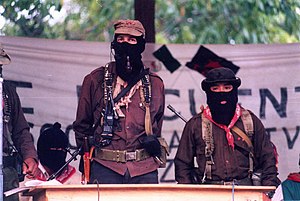
Diversity of tactics is a phenomenon wherein a social movement makes periodic use of force for disruptive or defensive purposes, stepping beyond the limits of nonviolent resistance, but also stopping short of total militarization.[1][2] It also refers to the theory which asserts this to be the most effective strategy of civil disobedience for social change.[3] Diversity of tactics may promote nonviolent tactics, or armed resistance, or a range of methods in between, depending on the level of repression the political movement is facing. It sometimes claims to advocate for "forms of resistance that maximize respect for life".[4]
- ^ Amory Starr, "...'Excepting Barricades Erected to Prevent Us from Peaceably Assembling'..." Archived 2022-04-19 at the Wayback Machine, Social Movement Studies, Vol. 5, No. 1, 61–81, May 2006.
- ^ "Tactical Diversity in Successful Social Movements" Archived 2014-05-30 at the Wayback Machine, Vancouver Media Co-op, January 14, 2013.
- ^ Anna Feigenbaum, "Death of a Dichotomy: Tactical Diversity and the Politics of Post-Violence" Archived 2014-05-30 at the Wayback Machine, Upping the Anti: A Journal of Theory and Action, May 2007.
- ^ ""Hallmarks of People's Global Action (updated at the 3rd PGA conference at Cochamamba, 2001)"". Archived from the original on 2013-11-09. Retrieved 2014-05-24.
© MMXXIII Rich X Search. We shall prevail. All rights reserved. Rich X Search
